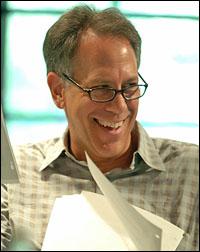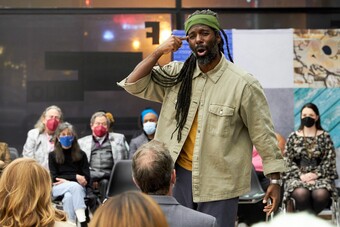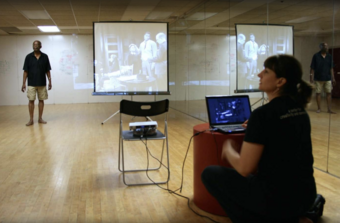What a "Renegade" New Play Fanatic Can Bring to the Leadership of the TCG Board
My Fellow Americans [with a passion for new plays],

Photo by TCG.
My ascendency to the throne—I mean, the Presidency—of Theatre Communications Group was swift, seemingly uncontested, and best of all, unmarred by any bothersome inauguration ceremony. Hence, you were all spared an inaugural address starring me in an ill-fitting Hugo Boss. At least—until now. When Polly Carl asked if I might contribute a perspective to HowlRound—specifically in my role as the new President of the TCG Board of Directors—it occurred to me that I would have to think profoundly about what it means to lead a new play development institution and at the same time, “lead” the trustees of an institution that tries mightily to represent the entire spectrum of the American theater. Dramaturg Scott T. Cummings once noted: “Theatre as an art form is already a marginalized fraction of American culture. New play development takes place in a margin of a margin.” So, what, if anything, is it that I might offer the broader field? Can my scribbles in the periphery of our precious world offer any substance or hope?
Let me clarify straight off that it is the extraordinary staff of TCG, lead by executive director Teresa Eyring who bear the real weight and concern, and whose successes past, present and yet to be unveiled, are a testament to concerted outreach, vision, and dedication. In just over four years, Teresa has introduced a vibrancy, diversity, and inclusion into TCG—the field’s largest umbrella and service organization—that did not exist earlier in the decade. The Los Angeles National Conference last June was filled with scores of new and younger faces, including independent artists and burgeoning young ensembles. Generational and culture diversity were apparent everywhere.
It was only after some self-inflicted Talmudic torment that I accepted the leadership of the TCG board. (It’s daunting to follow in Martha Lavey’s footsteps – she is not only brilliant and intuitive but sports fabulous Pashminas). I did so because I wanted to work closely with the devoted TCG staff, and, I suppose, share some essential responsibility in service to the larger American theatrical field; to be charged with some modicum of liability for its health in these unpredictable times.
The gift of “theater” was first bestowed on me by Marilyn Goler, an extraordinary high school drama teacher, my very own hip 1960’s “Jean Brodie.” No doubt, in her “prime,” and so able to convince a classroom of dopey sophomores that it was solely our “willing suspension of disbelief” that would bring us closer to the truths of our lives, that the words of theater writers promised revelation. When other schools performed Bye Bye Birdie, we were onto Ibsen, Anouilh, Dylan Thomas’ Under Milk Wood. The words of these authors were the keys that unlocked veracity, and the proscenium arch and painted scenery merely portals to the clearest expression of human emotion. The playwright’s words were our holy grail. Some forty odd years later, I now find myself in a leadership position for two organizations: the Sundance Institute Theatre Program where I am Producing Artistic Director and TCG as Board President. I harbor no doubt that it will be my ongoing exchange with living writers that informs my perspective on TCG’s role in our future.
My background is almost exclusively in working with new playwrights and new projects. From my earliest professional days at the birth of Playwrights Horizons, through my stint overseeing the Improvisational Theatre Project at the Mark Taper Forum, to the Sundance Institute Theatre Program, I have trafficked in the world of the yet-to-be-produced script. (Well, there was that one lapse, when I directed a revival of Fiddler On the Roof for the Sundance Outdoor Summer Stage, but it was with a virtually all-Mormon cast, so it was kind of a brilliant reinvention.)
Bob Moss, Founder and Artistic Director of Playwrights Horizons (and the inspiration for “Theater Row”), was one mentor. He produced thirty-five new plays each year on West 42nd Street, at what was a former “massage parlor.” We charged no admission; at the start of each play Bob gave a curtain speech extolling the role of the contemporary playwright in our society and at the end of the evening, stood at the back with a plastic bag to accept donations, including paper TDF “vouchers.” I was trained in that environment, and soon shared the sacred duty of the curtain speech and collection of dollar bills amid what was then the dark squalor of old 42nd Street. I suppose my present day impulse is to keep all future pathways clear and well-lit, so that our playwright/truth-tellers are unimpeded.
Clearly, TCG has always championed the living playwright; in fact, TCG is one of the largest publishers and distributors of new American plays, and American Theatre Magazine gives us the gift of a new script five times a year. This practice began in the mid 1980’s, under the stewardship of past TCG board president, Lloyd Richards (who led the Eugene O’Neill Playwrights Conference so brilliantly.) So, there is no doubt that “we” have had and continue to have a place at the TCG table. The more pressing questions we must wrestle concern something more critical: the ambition for the American theater to take its place at a vastly larger table. How does the American theater remain not simply solvent, but vital, relevant and part of the fabric of our democracy? How does theater in America reinsert its voice into a more immense national—and international—conversation?
Nowadays, I wake up and understand Barack Obama’s dilemma. At any given moment, it is likely that someone somewhere will be angry at TCG. The range of perspective within our field is just so wonderfully immense. TCG represents big institutional theaters wrestling new real estate, and tiny ensembles whose visions are not always concerned with longevity, much less bricks and mortar. Some do not rely upon a single playwright, but rather a process of collective creation—or are non-text based entirely. There are community-based and ethnically-specific companies with very focused issues, and independent artists who wish to be seen outside the confines of institutions. There are companies vying for competition in big urban markets and theaters in bucolic isolated rural outposts. And there are more and more independent artists from all theatrical disciplines. They are all part of TCG, needful and deserving of attention. What’s a President to do?
We theater folk rightly celebrate that theater in America is a bold and diverse reflection of our society, and the board of TCG reflects that range. On that board are two playwrights, as well as artistic directors, managing directors, marketers, designers, theater trustees, literary agents, and the heads of play development organizations (well, one: that be me). So, that still begs the question: do I have a responsibility to keep the issue of new plays and new writers aloft and hot in that boardroom? Or, might I be accused of a “secret agenda” by all those theaters solely devoted to producing older work and plays by writers no longer living? Could I single-handedly undermine all the Shakespeare theaters of America? Hardly. Nor would I aspire to.
The men and women who feel compelled to write for our form, do not aspire to have their words reach millions of people, or make tons of money, as their film and television cohorts do. For some reason what is vital to them is a tactile and quite treacherous experience that happens in real time, and it is genuinely from their valor that I garner my energy and hope. What we all crave from our American political leadership is what I see in the eyes, and words, of our playwrights. They are the ones standing on the edge of the high dive, breathing the same air as their audience, and being asked time and again, to take the plunge. What turns me on about new work is the very real risk and danger inherent in it. When I open a new script (and I open many each year), I feel like an explorer poised to unearth new terrain. And it is this spirit that I hope TCG and its membership will embrace.
It is the context of new work pushed up against other new work, that reveals meaning.
I wonder—what if the leader of every institutional and regional theater that programs new work embraced it too? What would that look like? Of course, there are many ways to invite “risk” into your institution. At some venues, one new title a season creates opportunity for high stakes audience engagement. But in my world, and in the best of circumstances, I imagine it might reflect seasons of new work, which some of our member theaters are testing out as I write. I sometimes find myself cautioning those artistic directors who complain that they “tried one new title in the season but no one came.” I remind them that if we entered Barnes and Noble and found but one new book sitting alone on the new arrivals table, we too would scuttle over to the classics shelf. It’s the body of new work that matters: the opportunity for an audience to engage in the range and diversity of what new writers are writing, side by side; it is the context of new work pushed up against other new work, that reveals meaning. Granted, these artistic directors have a real dilemma, because they have to fix a problem set up decades ago (sort of like Mr. Obama and the economy)—when who should lead, audiences or artists, got turned around. I don’t believe that audiences suddenly became less adventuresome in the Reagan Era. Artistic institutions tripped themselves up—substituting a better-known title or a popular star name here and there, where there once was something new, mysterious, and a genuine opportunity for discovery. Sometimes marketing teams and boards of directors swayed opinion. But in the end, it is the artistic director who is culpable and must lead this charge once more. Hopefully, it is in his or her DNA.
A character created by playwright Doug Carter Beane, (and I paraphrase badly) reminds us that “because government has ceased to tell us the truth, and organized religion has ceased to tell us the truth, and corporate business has never spoken the truth, it is left to the artist, [to the playwright], to take on that mantle.” If there is any lesson to be gleaned from the world of new play development, one that I bring to the conversation at TCG, it is that the hope of the future lies in our responsibility to speak truth—for no one else might. Like our desperate aspirations for our political leadership, I yearn for those that curate our theatrical seasons to be bold, to walk the walk, to leave conciliatory programming behind.
Whatever the frequency of programming new work, I entreat our theaters to use our playwrights to elevate the place of the institutional theater itself. Let them speak for you. What if we assured that the voice of the playwright went beyond the four walls of the stage and out into the larger community? What if every theater across America made it a goal, in 2012, to have a playwright from their community write an op-ed piece in the local newspaper? Not about theater, but about larger issues in that community, or nationally?
When TCG was created fifty years ago, a handful of visionary leaders imagined a network of American theaters strewn across the breadth of our land. One of them, Margo Jones, expressed hope that several dozen institutions would emerge. Now, TCG boasts over 500 theater organization members, with budgets from $50,000 to 50 million dollars, hundreds of businesses and educational institutions and 13,000 or more individual members. We are defined by our breathtaking range. I know TCG will continue to listen—carefully, wisely, deeply—to the entire constituency, and then based on intuition and intelligence take the necessary leaps to move the field forward. With the stroke of a pen, or a tap on the keyboard, a playwright engages with risk. And like that playwright, who operates without the comfort of a net, TCG—staff and board—will walk the tightrope, all the way to the other side. I sense and I trust that our constituency will join us on that journey.
However we want to measure the marginality of theater culture in the larger culture, there is something to be said about our members—they represent thousands of theater practitioners taking a stand, hundreds of thousands of audiences willing to listen and an array of organizations living on the wire in service to our form. In my two-year tenure, I can only aspire to find the strength, courage, and wisdom that I so admire in our playwrights and other generative theater artists, to support the TCG staff in envisioning an organization that can not only nimbly respond to its membership’s needs, but even more, can direct the field—with temerity, pride, and perilous audacity—into the thick of the twenty-first century.












Comments
The article is just the start of the conversation—we want to know what you think about this subject, too! HowlRound is a space for knowledge-sharing, and we welcome spirited, thoughtful, and on-topic dialogue. Find our full comments policy here
Hi, was the Marilyn Goler you mentioned teaching in Hamden Ct? I grad from Hamden High in 1967 and my Marilyn Goler instilled in me a love of the theater and I've wondered how to find her. Is this the same "Jean Brodie" charismatic figure? Do you know where she is?
I hope to hear from you.
kathy felgran
[email protected]
Super idea to have playwrights contribute op-eds. Along with texts, how about performances?
Makeshift platforms appear around the world ready for the high dives Philip mentions. Places such as Occupy Seattle have an open mic ready for courageous playwrights, intrepid performers and global citizens.
#OWS (!)
Kirsten Greenidge, who has been a resident playwright at the Huntington Theatre, is writing Op-Eds for the Boston Globe. Her first
was about audiences, and some of the comments in reaction chided her for presuming that audiences had something to learn from a writer rather than vice-versa. Subsequent columns have been more general. They are all vivid with insight and a pleasure to read.
viva la himberg!